| Species | Common name | Type | Image | Location(s) | Estimated population | Threats |
|---|
| Abies beshanzuensis | Baishan fir | Plant (Tree) | 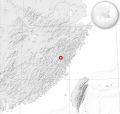 | Baishanzu Mountain, Zhejiang, China | Three mature individuals | |
| Actinote zikani | | Insect (butterfly) |  | Near São Paulo, Atlantic forest, Brazil | Unknown | - habitat loss from human expansion
|
| Aipysurus foliosquama | Leaf scaled sea-snake | Reptile |  | Ashmore Reef and Hibernia Reef, Timor Sea | Unknown | - unknown—probably degradation of coral reef habitat
|
| Amanipodagrion gilliesi | Amani flatwing | Insect (damselfly) |  | Amani-Sigi Forest, Usamabara Mountains, Tanzania | < 500 individuals | - population pressure and water pollution
|
| Antisolabis seychellensis | | Insect |  | Morne Blanc, Mahé island, Seychelles | Unknown | - invasive species
- climate change
|
| Antilophia bokermanni | Araripe manakin | Bird |  | Chapado do Araripe, South Ceará, Brazil | 779 individuals | - recreational facilities
- water diversion
|
| Aphanius transgrediens | Aci Göl toothcarp | Fish | 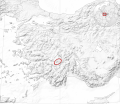 | south-eastern shore of former Lake Aci, Turkey | few hundred pairs | - competition and predation by Gambusia
- road construction
|
| Aproteles bulmerae | Bulmer's fruit bat | Mammal |  | Luplupwintern Cave, Western Province, Papua New Guinea | 150 | |
| Ardea insignis | White bellied heron | Bird |  | Bhutan, North East India and Myanmar | 70–400 individuals | |
| Ardeotis nigriceps | Great Indian bustard | Bird | 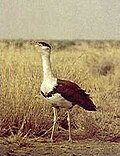 | Rajasthan, Gujarat, Maharashtra, Andhra Pradesh, Karnataka and Madhya, India | 50–249 mature individuals | - agricultural development
- energy transmission lines
|
| Astrochelys yniphora | Ploughshare tortoise | Reptile |  | Baly Bay region, northwestern Madagascar | 440–770 | - illegal collection for international pet trade
|
| Atelopus balios | Rio Pescado stubfoot toad | Amphibian |  | Azuay, Cañar and Guyas provinces, south-western Ecuador | Unknown | |
| Aythya innotata | Madagascar pochard | Bird |  | volcanic lakes north of Bealanana, Madagascar | 80 mature individuals | - agriculture
- hunting and fishing
- introduced fish
|
| Azurina eupalama | Galapagos damsel fish | Fish |  | Unknown | Unknown | - climate change
- oceanographic changes related to the 1982/1983 El Nino
|
| Bahaba taipingensis | Giant yellow croaker | Fish | | Chinese coast from Yangtze River, China to Hong Kong | Unknown | - over-fishing due to value of swim-bladder in traditional medicine
|
| Batagur baska | Common batagur | Reptile (turtle) |  | Bangladesh, Cambodia, India, Indonesia and Malaysia | Unknown | |
| Bazzania bhutanica | | Plant | | Budini and Lafeti Khola, Bhutan | 2 sub-populations | |
| Beatragus hunteri | Hirola | Mammal (antelope) |  | South-east Kenya and possibly south-west Somalia | < 1,000 individuals | - habitat loss
- competition with livestock
- poaching
|
| Bombus franklini | Franklin's bumblebee | Insect (bee) |  | Oregon and California | Unknown | |
| Brachyteles hypoxanthus | Northern muriqui
Woolly spider monkey | Mammal (primate) | 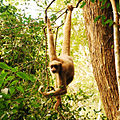 | Atlantic forest, south-eastern Brazil | < 1,000 | - large-scale deforestation and logging
|
| Bradypus pygmaeus | Pygmy three-toed sloth | Mammal |  | Isla Escudo de Veraguas, Panama | < 500 | |
| Callitriche pulchra | | Plant (freshwater) | | pool on Gavdos, Greece | Unknown | - habitat exploitation by livestock
- modification of the pool by locals
|
| Calumma tarzan | Tarzan's chameleon | Reptile | 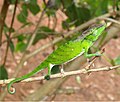 | Anosibe An'Ala region, eastern Madagascar | < 100 | |
| Cavia intermedia | Santa Catarina's guinea pig | Mammal (rodent) |  | Moleques do Sul Island, Santa Catarina, Brazil | 40–60 | - habitat disturbance
- possible hunting
- result of having such a small population
|
| Cercopithecus roloway | Roloway guenon | Mammal (primate) |  | Côte d'Ivoire | Unknown | |
| Coleura seychellensis | Seychelles sheath-tailed bat | Mammal (bat) |  | Two small caves on Silhouette and Mahé, Seychelles | < 100 | - habitat degradation
- predation by invasive species
|
| Cryptomyces maximus | Willow blister | Fungi |  | Pembrokeshire, United Kingdom | Unknown | |
| Cryptotis nelsoni | Nelson's small-eared shrew | Mammal (shrew) |  | Volcán San Martín Tuxtla, Veracruz, Mexico | Unknown | - logging
- cattle grazing
- fire
- agriculture
|
| Cyclura collei | Jamaican iguana
Jamaican rock iguana | Reptile |  | Hellshire Hills, Jamaica | Unknown | |
| Daubentonia madagascariensis | Aye-aye | Mammal (primate) |  | Deciduous forest, East Madagascar | Unknown | |
| Dendrophylax fawcettii | Cayman Islands ghost orchid | Plant (orchid) | | Ironwood Forest, George Town, Grand Cayman | Unknown | - infrastructure development
|
| Dicerorhinus sumatrensis | Sumatran rhino | Mammal (rhino) |  | Sabah, Sarawak and Peninsular Malaysia, Kalimantan and Sumatra, Indonesia | < 100 | - hunting (horn is used in traditional medicine)
|
| Diomedea amsterdamensis | Amsterdam albatross | Bird |  | Breeds on Plateuau des Tourbières, Amsterdam Island, Indian Ocean. | 100 mature individuals | - disease
- incidental by-catch in long-line fishing
|
| Dioscorea strydomiana | Wild yam | Plant | | Oshoek area, Mpumalanga, South Africa | 200 | - collection for medicinal use
|
| Diospyros katendei | | Plant (tree) | | Kasyoha-Kitomi Forest Reserve, Uganda | 20 individuals in a single population | - agricultural activity
- illegal tree felling
- alluvial gold digging
- small population
|
| Dipterocarpus lamellatus | | Plant (tree) | | Siangau Forest Reserve, Sabah, Malaysia | 12 individuals | - logging of lowland forest
- creation of industrial plantations
|
| Discoglossus nigriventer | Hula painted frog | Amphibian |  | Hula Valley, Israel | Unknown | |
| Dombeya mauritiana | | Plant | | Mauritius | Unknown | - encroachment by invasive plant species
- habitat loss due to cannabis cultivation
|
| Elaeocarpus bojeri | Bois Dentelle | Plant (tree) |  | Grand Bassin, Mauritius | < 10 individuals | |
| Eleutherodactylus glandulifer | La Hotte glanded frog | Amphibian |  | Massif de la Hotte, Haiti | Unknown | - charcoal production
- slash-and-burn agriculture
|
| Eleutherodactylus thorectes | Macaya breast-spot frog | Amphibian |  | Formon and Macaya peaks, Masif de la Hotte, Haiti | Unknown | - charcoal production
- slash-and-burn agriculture
|
| Eriosyce chilensis | Chilenito (cactus) | Plant |  | Pta Molles and Pichidungui, Chile | < 500 individuals | - collection of flowering plants
|
| Erythrina schliebenii | Coral tree | Plant | | Namatimbili-Ngarama Forest, Tanzania | < 50 individuals | - limited habitat and small population size increase vulnerability
|
| Euphorbia tanaensis | | Plant (tree) |  | Witu Forest Reserve, Kenya | 4 mature individuals | - illegal logging
- agricultural expansion
- infrastructure development
|
| Eurynorhyncus pygmeus | Spoon-billed sandpiper | Bird |  | Breeds in Russia, migrates along the East Asian-Australasian Flyway to wintering grounds in India, Bangladesh and Myanmar | 100 breeding pairs | |
| Ficus katendei | | Plant | | Kasyoha-Kitomi Forest Reserve, Ishasha River, Uganda | < 50 mature individuals | - agriculture
- illegal tree felling
- alluvial gold digging
|
| Geronticus eremita | Northern bald ibis | Bird |  | Breeds in Morocco, Turkey and Syria. Syrian population winters in central Ethiopia. | about 3000 individuals | - habitat degradation and destruction
- hunting
|
| Gigasiphon macrosiphon | | Plant (flower) |  | Kaya Muhaka, Gongoni and Mrima Forest Reserves, Kenya, Amani Nature Reserve, West Kilombero Scarp Forest Reserve, and Kihansi Gorge, Tanzania | 33 | - timber extraction
- agriculture encroachment and development
- predation by wild pigs
|
| Gocea ohridana | | Mollusc |  | Lake Ohrid, Macedonia | Unknown | - increasing pollution levels
- off-take of water
- sedimentation events
|
| Heleophryne rosei | Table mountain ghost frog | Amphibian |  | Table Mountain, Western Cape Province, South Africa | Unknown | - invasive plants
- water abstraction
|
| Hemicycla paeteliana | | Mollusc (land snail) | | Jandia peninsula, Fuerteventura, Canary Islands | Unknown | - overgrazing
- trampling by goats and tourists
|
| Heteromirafa sidamoensis | Liben lark | Bird |  | Liben Plains, southern Ethiopia | 90–256 | - agricultural expansion
- overgrazing
- fire suppression
|
| Hibiscadelphus woodii | | Plant (tree) | | Kalalau Valley, Hawaii | Unknown | - habitat degradation due to feral ungulates
- competition with invasive plant species
|
| Hucho perryi | Sakhalin taimen | Fish |  | Russian and Japanese rivers, Pacific Ocean between Russia and Japan | Unknown | - overfishing
- damming
- agriculture
- other land use
|
| Johora singaporensis | Singapore freshwater crab | Crustacean | | Bukit Timah Nature Reserve and streamlet near Bukit Batok, Singapore | Unknown | - habitat degradation due to reduction in water quality and quantity
|
| Lathyrus belinensis | Belin vetchling | Plant |  | Outskirts of Belin village, Antalya, Turkey | < 1,000 | - urbanisation
- over-grazing
- conifer planting
- road widening
|
| Leiopelma archeyi | Archey's frog | Amphibian |  | Coromandel peninsula and Whareorino Forest, New Zealand | Unknown | |
|
| Lithobates sevosus | Dusky gopher frog | Amphibian |  | Harrison County, Mississippi, USA | 60–100 | - fungal disease
- climate change
- land-use changes
|
| Lophura edwardsi | Edwards's pheasant | Bird |  | Quang Binh, Quang Tri and Thua Thien-Hue, Viet Nam | Unknown | |
| Magnolia wolfii | | Plant (tree) | | Risaralda, Colombia | 3 | - isolation of species
- low regeneration rates
|
| Margaritifera marocana | | Mollusc | | Oued Denna, Oued Abid and Oued Beth, Morocco | < 250 | |
| Moominia willii | | Mollusc (snail) | | Silhouette Island, Seychelles | < 500 | - invasive species
- climate change
|
| Natalus primus | Cuban greater funnel eared bat | Mammal (bat) |  | Cueva La Barca, Isle of Pines, Cuba | < 100 | - habitat loss
- human disturbance
|
| Nepenthes attenboroughii | Attenborough's pitcher plant | Plant |  | Mount Victoria, Palawan, Philippines | Unknown | |
| Nomascus hainanus | Hainan black crested gibbon | Mammal (primate) |  | Hainan Island, China | 20 | |
| Neurergus kaiseri | Luristan newt | Amphibian |  | Zagros Mountains, Lorestan, Iran | < 1,000 | - illegal collection for pet trade
|
| Oreocnemis phoenix | Mulanje red damsel | Insect (damselfly) | | Mulanje Plateau, Malawi | Unknown | - habitat destruction and degradation due to drainage
- agricultural expansion
- exploitation of forest
|
| Pangasius sanitwongsei | Pangasid catfish | Fish |  | Chao Phraya and Mekong basins in Cambodia, China, Lao PDR, Thailand and Viet Nam | Unknown | - overfishing
- collection for aquarium trade
|
| Parides burchellanus | | Insect (butterfly) |  | Cerrado, Brazil | < 100 | - human expansion
- limited range
|
| Phocoena sinus | Vaquita | Mammal (porpoise) |  | Northern Gulf of California, Mexico | 12 [7] | - capture in fishermen's gillnets
|
| Picea neoveitchii | Type of spruce tree | Plant (tree) |  | Qinling Range, China | Unknown | |
| Pinus squamata | Qiaojia pine | Plant (tree) | | Qiaojia, Yunnan, China | < 25 | - limited distribution
- small population size
|
| Poecilotheria metallica | Gooty tarantula
Metallic tarantula
Peacock tarantula
Salepurgu | Spider |  | Nandyal and Giddalur, Andhra Pradesh, India | Unknown | - deforestation
- firewood collection
- civil unrest
|
| Pomarea whitneyi | Fatuhiva monarch | Bird |  | Fatu Hiva, Marquesas Islands, French Polynesia | 50 | |
| Pristis pristis | Common sawfish | Fish |  | Coastal tropical and subtropical waters of Indo-Pacific and Atlantic Oceans. Currently largely restricted to northern Australia | Unknown | - exploitation has removed the species from 95 per cent of its historical range
|
| Hapalemur simus | Greater bamboo lemur | Mammal (primate) | 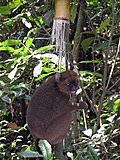 | Southeastern and southcentral rainforests of Madagascar | 500 | - agriculture
- mining
- illegal logging
|
| Propithecus candidus | Silky sifaka | Mammal (primate) |  | Maroantsetra to Andapa basin, and Marojeju Massif, Madagascar | 100–1,000 | - hunting
- habitat disturbance
|
| Psammobates geometricus | Geometric tortoise | Reptile |  | Western Cape Province, South Africa | Unknown | |
| Pseudoryx nghetinhensis | Saola | Mammal |  | Annamite mountains, on the Viet Nam - PDR Laos border | Unknown | |
| Psiadia cataractae | | Plant | | Mauritius | Unknown | - development project
- competition from invasive plant species
|
| Psorodonotus ebneri | Beydaglari bush-cricket | Insect | | Beydaglari range, Antalaya, Turkey | Unknown | - climate change
- habitat loss
|
| Rafetus swinhoei | Red River giant softshell turtle | Reptile |  | Hoan Kiem Lake and Dong Mo Lake, Viet Nam, and Suzhou Zoo, China | 3 | - hunting for consumption
- wetland destruction
- pollution
|
| Rhinoceros sondaicus | Javan rhino | Mammal (rhino) |  | Ujung Kulon National Park, Java, Indonesia | < 100 | - hunting for traditional medicine
- small population size
|
| Rhinopithecus avunculus | Tonkin snub-nosed monkey | Mammal (primate) |  | Northeastern Vietnam | < 200 | |
| Rhizanthella gardneri | West Australian underground orchid | Plant (orchid) | 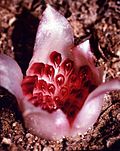 | Western Australia, Australia | < 100 | - land clearance for agriculture
- climate change
- salinisation
|
| Rhynchocyon spp. | Boni giant sengi | Mammal |  | Boni-Dodori Forest, Lamu area, Kenya | Unknown | - development causing habitat loss
|
| Risiocnemis seidenschwarzi | Cebu frill-wing | Insect (damselfly) |  | Rivulet beside the Kawasan River, Cebu, Philippines | Unknown | - habitat degradation and destruction
|
| Rosa arabica | | Plant |  | St Katherine Mountains, Egypt | Unknown, 10 sub-populations | - domestic animal grazing
- climate change and drought
- medicinal plant collecting
- limited range
|
| Salanoia durrelli | Durrell's vontsira | Mammal (mongoose) |  | Marshes of Lake Alaotra, Madagascar | Unknown | |
| Santamartamys rufodorsalis | Red crested tree rat | Mammal (rodent) |  | Sierra Nevada de Santa Marta, Colombia | Unknown | - urban development
- coffee cultivation
|
| Scaturiginichthys vermeilipinnis | Red-finned blue-eye | Fish | | Edgbaston Station, central western Queensland, Australia | 2,000–4,000 | - predation by introduced species
|
| Squatina squatina | Angel shark | Fish |  | Canary Islands | Unknown | |
| Sterna bernsteini | Chinese crested tern | Bird |  | Breeding in Zhejiang and Fujian, China. Outside breeding season in Indonesia, Malaysia, Philippines, Taiwan, Thailand. | < 50 | |
| Syngnathus watermeyeri | Estuarine pipefish | Fish |  | Kariega Estuary to East Kleinemonde Estuary, Eastern Cape Province, South Africa | Unknown | - dam construction is altering river flows
- flood events into estuaries
|
| Tahina spectabilis | Suicide palm
Dimaka | Plant |  | Analalava district, north-western Madagascar | 90 | - fires
- logging
- agricultural developments
|
| Telmatobufo bullocki | Bullock's false toad | Amphibian (frog) |  | Nahuelbuta, Arauco Province, Chile | Unknown | - construction of hydro-electricity
|
| Tokudaia muenninki | Okinawa spiny rat | Mammal (rodent) |  | Okinawa Island, Japan | Unknown | - habitat loss
- predation by feral cats
|
| Trigonostigma somphongsi | Somphongs's rasbora | Fish |  | Mae Khlong basin, Thailand | Unknown | - farmland conversion and urbanization
|
| Valencia letourneuxi | | Fish | | Southern Albania and Western Greece | Unknown | |
| Voanioala gerardii | Forest coconut | Plant |  | Masoala peninsula, Madagascar | < 10 | - deforestation
- harvesting for consumption of palm heart
|
| Zaglossus attenboroughi | Attenborough's echidna | Mammal |  | Cyclops Mountains, Papua Province, Indonesia | Unknown | - habitat modification and degradation
- logging
- agricultural encroachment shifting cultivation and hunting by local people
|













































































